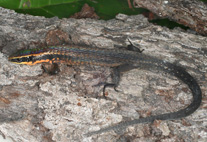Abstract
We describe a new genus and two new species of gymnophthalmid lizards based on specimens collected from Brazilian Amazonia, mostly in the "arc of deforestation". The new genus is easily distinguished from other Gymnophthalmidae by having very wide, smooth, and imbricate nuchals, arranged in two longitudinal and 6–10 transverse rows from nape to brachium level, followed by much narrower, strongly keeled, lanceolate, and mucronate scales. It also differs from all other Gymnophthalmidae, except Iphisa, by the presence of two longitudinal rows of ventrals. The new genus differs from Iphisa by having two pairs of enlarged chinshields (one in Iphisa); posterior dorsal scales lanceolate, strongly keeled and not arranged in longitudinal rows (dorsals broad, smooth and forming two longitudinal rows), and lateral scales keeled (smooth). Maximum parsimony, maximum likelihood, and Bayesian phylogenetic analyses based on morphological and molecular data indicate the new species form a clade that is most closely related to Iphisa. We also address several nomenclatural issues and present a revised classification of Gymnophthalmidae.

